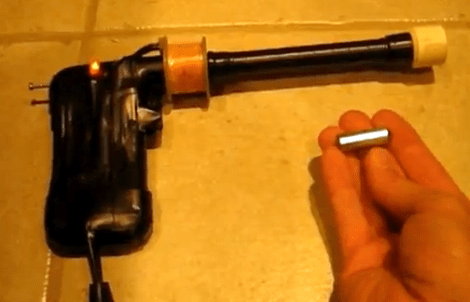
[Lou’s] latest tutorial details the process of turning an electric stapler into a coil gun. The stapler is the expensive part, but the rest is pretty simple. He used PVC pipe and a handful of fittings along with a few supplies you probably have kicking around your shop.
It’s surprising how perfect the Bostitch stapler (from which the parts were pulled) is for this project. The mechanism that drives the staples into your pages uses a solenoid with a rather large coil. To turn it into a coil gun you simply need to replace the core of the solenoid with a metal projectile. In the video after the break [Lou] shows us how to make a barrel onto which the coil can be mounted. From there he uses a wooden spacer to position a hunk of smooth metal from a bolt which serves as the projectile. The stapler’s original drive circuitry and trigger mechanism do the rest.















Neat hack
I noticed that it doesn’t have a big juicy super cap that would potentially make it scarier.
And there is no recharge time! Hmmm. Next a machine coil gun? :)
That’s because it’s powered from the wall, which actually makes it more scary since the guy basically built the trigger mechanism out of a nail, that touches the circuit board, and is isolated from his finger by a thin strip of electrical tape.
No it’s not touching the circuit. The trigger is an optical beam interrupted by the nail.
I’d be more worried to handle repeatdly the device with the circuit being insulated only by electric tape.
Already done: http://www.youtube.com/watch?v=eHv33mH6Nq0
I first thought this was just another coil gun, but that is pretty impressive power. If ever I find an old stapler like that for free, I’ll probably make one just for sh%^s and giggles.
The irony is that if he would use the steel projectile as a piston operated blowgun instead, the gun would achieve higher efficiency and higher exit velocity, and he would have a pretty nifty electric airgun.
Solenoids have better efficiency when the cross-section of the plunger is large and the travel distance is short. All homemade coilguns waste 2000+ Joules on a shot to deliver 2 Joules of muzzle energy whenever they try to shoot faster than you can throw, whereas if they re-designed the solenoid into a gas piston instead, they’d easily deliver 20-200 Joules which would bring them into the realm of low powered actual firearms.
Pretty cool. Too bad it’s tethered to mains wiring. Although an indoor shooting gallery game with a few of these would be awesome. Hmmm….
Set it up like the arrow traps in fantasy games. The trigger is already an optical switch, so the only design change is to move that switch to your foyer. :D
Yeah, I’d probably just take the coil and scrap everything else. It’s not worth the modification that’d have to be done unless you really like the idea of having that little light and optical sensor for a trigger.
I’ve been thinking about coil guns recently and was wondering if there would be any advantage to using electropermanent magnets. That is where you use energy to toggle a magnetic field, so the power draw only comes when changing the field. Sure the field strength may not be as powerful as from a coil but it may not need such huge capacitors.
Yeah of course coil guns are works greatly. I think it’s use only hard things. But it use be care fully.
Can you make it portable?
That you will need a capacitor,batteries,etc.
Because I want to build a coil gun but you will need disposable camera and I don’t have a disposable camera until I found this tutorial of making coil gun out of electric stapler!
After I watched the video the coil gun is not portable you will need to plug it!
So I suggest that you will turn it to portable add some capacitors and batteries!
Please make it!
Because I want to make too! I already have the electric stapler!
Make sure it is so powerful!
THANKS!!!
awesome dude. It was a cool DIY idea man I liked it. I Wanna try it badly.
thanks for the cool DIY idea man.
I’m doing something similar and have a question about the control board. If I remove the control board and hook the power cord directly to the coil, will that cause a problem?
I should let you know my goal.
I want the solenoid to remain powered for 3 to 4 seconds instead of an immediate trigger on off thus leaving the magnet active during the time i’m depressing the SPST intermittent button. The magnet only goes off when I release the button.
How can this be achieved?
Thank you
Allan
I figured it out.
I need to use a 12 V battery.
Thank you anyway
Allan